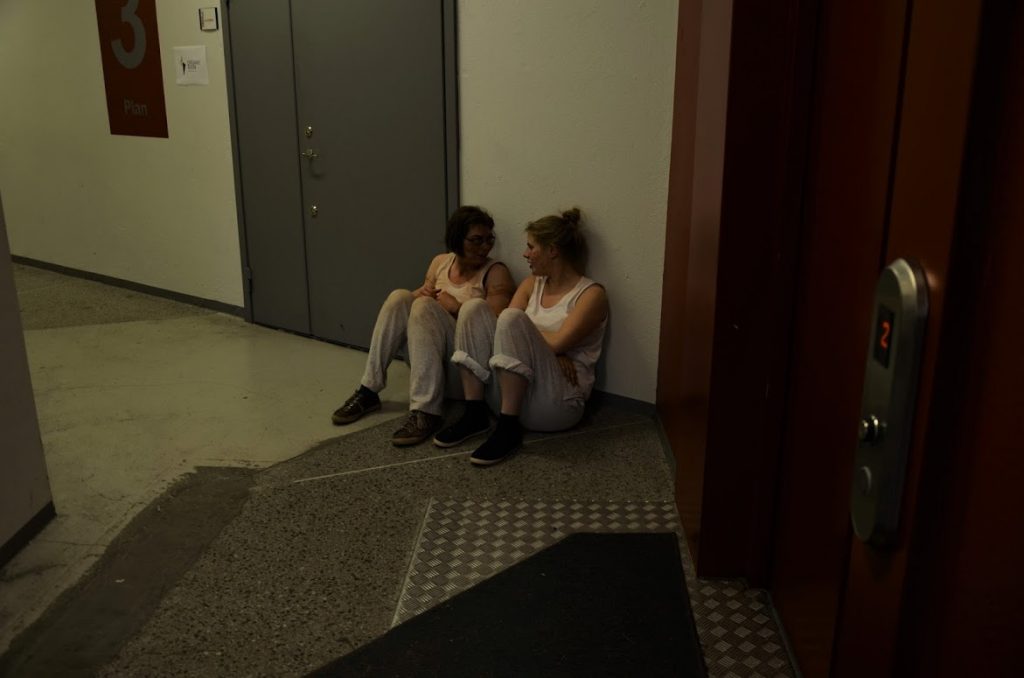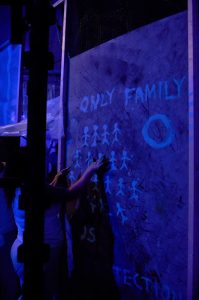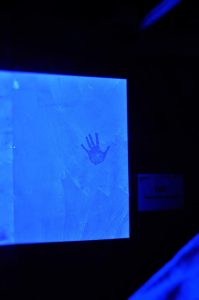Today, Swedish larpwright Siri Sandquist discusses her recent experience as a gamemastering character in The Solution.
In this review of the larp The Solution I have chosen to focus on what happens when designers purposely write a character with the intention of encouraging the player to steer and game master from within. The strengths and weaknesses this brings to the table and how my player experience of the larp was colored by this design choice.
The Plot
The Solution was a Swedish/Danish larp project that took place in Gothenburg, June 2016. Heavily inspired by larps like Kapo and social experiments such as the Stanford Prison experiment it was promoted as a hard-core, physically and emotionally challenging Nordic larp.
Participants would enter the project at three different points during the game. I myself was a part of the “first wave”, scheduled to play the whole 46 hours. During these hours ranging from 24-46, participants would play ordinary Swedish citizens taking part in a psychological experiment aimed at finding a solution to societal issues such as violence and war. Once in the project they should do their very best to comply with the experiment even if it went against their own moral and ethical code. The characters’ incentives for this varied from genuine belief in the importance and “need” for the project to the desire for the extraordinary pay-off after completing it, ten years salary worth of cash.
The Characters
Directly upon entering the project we got a new name, which we were to use with the other participants. Then as the “first wavers” we were divided into four study groups and given a sheet of paper with instructions. Each study group was to use these instructions as rules for their groups behaviour inside the complex. In reality we, the players had already constructed these cultures during an extensive workshop the day before. At the workshop, we had also received a sheet of paper from the organizers with basic guidelines for the goal of each group. The study group I had chosen off-game (but assigned to in-game) was based on football hooligans and animalistic tribes. We were meant to gradually lose our humanity, becoming less and less verbal and more and more violent.
Being a majority of nordic larpers we knew what players most likely expected and wanted to experience in-game: oppression and being oppressed. All groups appeared to design with this in mind. In-game the new names began to function as alibis for our own and our groups actions, sort of like larp characters-within-larp-character. They became the personas we could use to uphold the cultures we had created.
When the “second wave” of participant was let into the complex our characters had been instructed to act as if they had been in there for several months already and truly had become their study groups. Even if they had only been there for a couple of hours in “reality.” Larpers being larpers, the new wave readily bought that we were completely insane. This helped speed up their own descent into, as in my study group’s case, crazy wolf-like tribal behaviour. By the time the “third wave” of participants came into the complex many characters had started to lose their humanity and sanity “for real”, across the groups.
My character was a director and a method actor, highly motivated to make sure the project “succeeded”. She used her skills at acting and controlling a “scene” to knowingly manipulate the other participants into following the rules of the project. For me it was obvious from a game design point of view that my character was explicitly written to game master from within the larp. My character “the director” was motivated to take whatever position needed within the group to push the others to uphold the culture they had constructed. Off-game this inevitably began to include managing the pacing and the dynamics between the four different groups as well as within my own study group, taking the overall dynamic of the larp into consideration.
To direct a larp from within
Off-game, I felt responsible for getting the study group to function. I, as well as other “first wave” participants with the same type of character description took this game mastering responsibility very seriously. In hindsight, maybe too much so.
During most of the game I was constantly off-game in my mind. In our group we had a hierarchal system with an Alpha ruling, the Betas supporting and vying for the top spot and the Omegas as the targets for abuse. The participants were supposed to move between these positions constantly by use of violence and oppression. Trying to figure out how to help, support, and encourage players to move around in the status ladder, (so that the ones on top and on the bottom would not get too tired) was a fulltime job. After all, I neither wanted nor could I force players to do something if they didn’t want to.
I was also acutely aware that we were supposed to function as a sort of constant and tangible threat of violence for the players in the other study groups. That threat was meant to enhance others’ experience in the same way, just as the other three groups of crazy were supposed to enhance our experience. As a result, on a player level, I was constantly preoccupied with analyzing how the game was doing: were the players tired? Bored? Only having internal play? Were we being active enough both outwardly and inwardly? Were the players in more demanding positions OK, or did they need a break?
The constant pressure meant I had no room to play on my character’s own motivations or relationships. But this was my own fault, and not that of the organizers. I had a perfect alibi in my character of “the director” to do the exact same thing in-game as I was doing off-game. As an actor and director, my character actually did have the flexibility of playing just as crazy, strong, or broken as she felt the project needed her to be. That gave me, as a player, the perfect alibi for immersion while steering the game.
At the same time, there was just not enough room, between lack of sleep and food and stress to try and immerse myself and add that extra level. Instead I would decide, off-game, what needed to happen, and then jump into one of the characters my character was playing to provoke things into action. Are you getting confused? Get in line…

One of the other participants and I plan a scene off-game, outside the venue during runtime. Photo: Sandra Orav
However, I do think these layers of character became both interesting and challenging, especially for the “first wave”. We were essentially playing characters that played characters, and the off-game instructions from the organizers told us to let go of our first layer of character gradually, and sink into the persona we had been given upon entering the project. The result was some of my most intense larp scenes ever, but that I was completely off-game in my mind as I had them.
The importance of relationships
During the workshops we made the pre-written relationships in our character sheets our most important focus, our core group. These would serve as a link back to our characters’ humanity and previous life, and allow us to also play the ordinary Swedish people we had been upon entering the project. Presumably to aid in this emotional turmoil, each group of people who had known each other before the project was supposed to spread themselves out over the four study groups. The ingame rules added to this: you were not supposed to leave your study group or speak to people from other study groups, which would, of course, create a Romeo and Juliet-esque longing for your prior associations in the so-called core groups. Your character would desperately want to connect with their friends, their safe haven: but the system would not allow it. The idea was no doubt “secret meetings” and “meaningful, longing looks”. But essentially, the game design blocked us from doing this, despite the organizers’ intentions.

Study group 3–“the family”–and the art of their members, who were instructed to completely cut all ties upon joining. Photo: Sandra Orav
This was particularly noticeable when it came to the players in the “first wave”. We had the responsibility of upholding the rules of the project and to teaching the new ones the rules without ever explaining them to them verbally. “Show don’t tell.” We had an especially hard time meeting and talking to the other characters in our core group, since doing so could actually affect the game, by undermining our characters’ work in their groups.
It might have been possible to circumvent this (I know other players did), except that my character had no close relationships at all. Her only pre-written relationships were with three actors she’d met on occasion. The most positive one was with an actor she’d admired on stage and would like to work with in the future. Had we had more time to interact as our “normal” characters before having to go into the project personas I think this could have been worked around without breaking the game or the characters. However, we had about 15 minutes standing in line, three hours in a white room where we were not allowed to talk and then about three hours where we had to set up our study groups and prepare for the newcomers. There was no room for my character to get to know her old acquaintances well enough to actually make the relationships matter in the way the organizers had intended. And that was even after I completely broke away from how my character was written during the silent period in the white room, to be able to bond even a little with the others in my core group.
As I was one of the people who wrote characters for the game I am partly to blame for this. The problem was that we as character writers did not have any idea of what would happen during the larp. We knew that these relationships were supposed to be important, and that they would be split up once they entered the project. However, the way it played out, the groups were not sent in together. This meant that once one person came in, their study group almost immediately assimilated them and they could no longer interact freely with their friends and relations as they arrived. I think it would have worked better to send in the core groups together, and let the internal pressure of the complex separate them. The first moments of confusion upon entering would make characters seek comfort in any familiar face, instantly making the core group relationships stronger and more meaningful.
A mixture of highs and lows
For me,The Solution was a mixed experience. In many ways, it was among my best larp experiences. It had mindblowing scenography–the sound and light was beautiful–and I had one of my strongest larp endings to date. I pushed myself as a player, and had some really strong emotional scenes that I am very grateful for. But in the end the experience left me a bit empty. Not only my stomach, after eating tasteless mush that turned bad in the heat of the complex. I was disappointed that I only managed to actually play my character during some very small scenes, due to my off-game feeling of responsibility. The organizers couldn’t have done anything about that, necessarily, as it happened organically.
My biggest struggle after the game ended was a bad conscience. Did I steer the game wrong? Make the wrong choices? Did I ruin my co-players’ experience by my decisions? This sort of, stage fright if you will, can happen to the best of us while larping. That I felt partly responsible for making my study group, and therefore a quarter of the larp, function made the feeling so much worse.Therein lies my biggest critique of this larp: I, as a paying participant, could not shake the feeling of being responsible for my co-players’ experience more than my own.
Maybe this is how it always is: we are always responsible for each other’s experiences. That is the very meaning of participant culture and co-creation. But in this case, it rubs me the wrong way, because the extent of the responsibility surprised me. If I had been there as an NPC, it would have been fine. It might even have been fine to be a paying participant in this role, if I had signed up with a clear understanding of exactly the extent of my off-game responsibility. Instead I ended up in a situation where my character was responsible for game mastering. As a player, I had to interpret whether this extended into off-game responsibility, since we had no oral or written instructions about what the organizers wanted us to do. In a sandbox game with only minimal organizer input during runtime, this was difficult. I, and some other “first wavers” felt confused and insecure about our responsibilities and the tools we had at our disposal to achieve whatever it was the organizers wanted us to do. If we look at it like this, the result is perhaps unsurprising: I left the experience, happy for some of my strong scenes, but utterly disappointed in myself when it came to parts of my game mastering.
Concluding thoughts
I think the game design aims of The Solution were very clever. The idea of writing characters to automatically and dynamically steer the game from within is brilliant in its simplicity. However, it stumbled on the finish line, mostly due to the confusion of having so many layers of character atop one another. I think the idea is interesting and worth exploring further, with some modifications:
- Clear communication between the organizers and the player about the players’ off-game responsibility for making the larp work, and what the characters’ ingame responsibility.
- Clear instructions about what the organizers want to achieve, and how the characters were written to help work towards (or if they don’t want to achieve anything, clear instructions around that).
- Tools for the players of these “steering characters” to prepare before the game, knowledge of the in-game set-up, and a special forum for pre-game discussions and organization.
- Relief for these characters built into the game design. 46 hours straight is a long time to game master at an intensive, physically draining larp.
Had I gotten these tools I think it might have been easier for me to feel secure with my decisions and maybe even more comfortable to let myself actually play my character.
_______
Siri Sandquist is a Swedish larp designer and larper. She has designed larps since 2014 and currently works as a larp pedagogue with LajvVerkstaden.
LeavingMundania.com owes its existence to the continued support of many wonderful Patrons. If you enjoyed this post, consider joining the conflagration of awesome people underwriting my blog on Patreon.


Here’s what I liked at this piece of critique: I thought it did a good job of pointing out both strengths and weaknesses of the design, and evaluating the larp according to the larp’s own design aims.
To me, exploring the roles of characters who also gamemaster will be increasingly vital as the rise of the blockbuster larp continues. Blockbuster larps draw large audiences of experienced and new larpers, and it makes sense for designers to lean on experienced players in key roles, who can give plot to others. So I think we’ll be seeing more of this sort of design in the future.